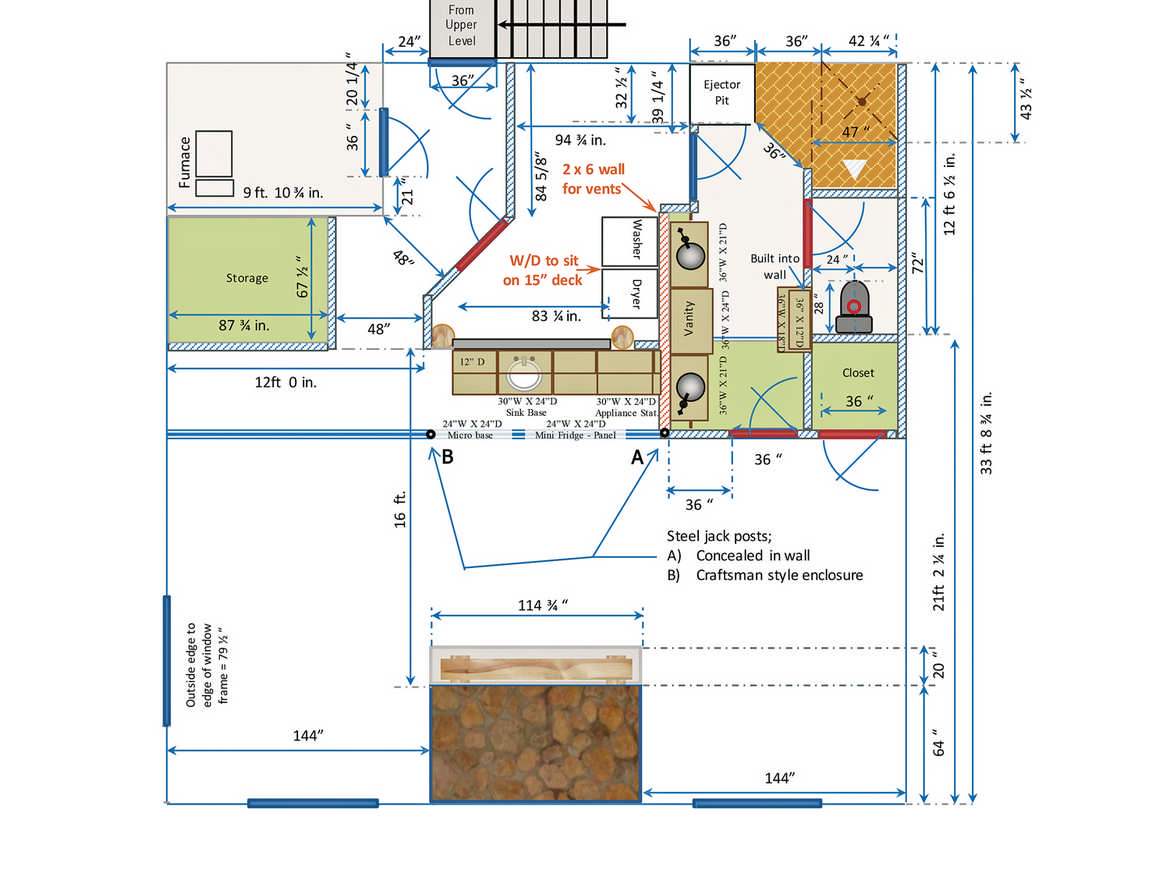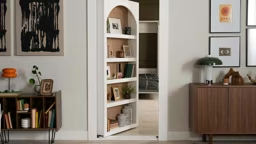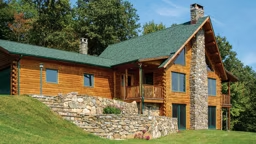
Blueprints are nothing more than copies of the final plans drawn up for the homeowners' approval. Highly detailed, these documents contain a wealth of information. Typically, a log home blueprint package includes a set of drawings called elevations, illustrating exterior and interior walls. But that's not all. The package contains other drawings. One is of your building site, and another drawing illustrates the foundation of the house. The reflected ceiling plan reveals where light fixtures are to be placed.
In addition, each blueprint incorporates a materials list with sizes and quantities of all necessary components required to construct the building features. This information enables the contractor to compile building costs. There is one additional category of blueprints — the floor plans — with which people are probably the most familiar.
Here's an insider's guide to reading the plans to your dream home.
1. Scale and dimensions for your log home are clearly indicated.
The scale of blueprints may be 1/4-inch or 1/2-inch to the foot. Whatever the scale, it will be noted in one of the lower corners of the blueprint. All blueprints for a log house are drawn to the same scale. Dimensions are noted in feet and inches. In most cases, the length and width of all the exterior walls are shown in addition to dimensions of each room. With this information in hand, you can easily determine which rooms are best sized for various family activities. You can also plan for the arrangement of furnishings.
2. Exterior walls are represented by thick parallel lines, and interior walls are represented by thinner lines.
The placement of the walls, particularly the decisions you make regarding the interior partition walls, greatly affect the layout of your log home. And if you can understand the exact placement when you first receive the blueprints, you'll likely make fewer changes as the process evolves, cutting down on unnecessary and unforeseen expenses to your project.
3. Rooms are clearly labeled by function: kitchen, living, dining, etc.
Built-in items within rooms also are presented in a logical fashion. For example, as you study the documents, fireplaces, closets and built-ins become obvious. Also apparent are the placement of kitchen and bathroom fixtures, counters, sinks, cabinetry and appliances.
4. It's easy to determine ceiling configurations and two-story rooms in log home blueprints.
A series of parallel dashes across a room denotes a ceiling beam; an arrow accompanied by the word "sloped" marks a cathedral ceiling. A double-height room is easy to spot. The blueprint of the lower level bears the notation "open to above" and the upper level "open to below."
5. Doors are represented by a straight line.
When you study the blueprint of your log home's floor plan, pretend that you are walking through the actual house. Visualize the two-dimensional blueprints in a three-dimensional form. This technique helps you transform the data and symbols into something more real. A good place to start is at the entryway. From there, you can clearly see the overall organization of your log home's interior. In houses designed today, rooms are placed into one of three zones dedicated to living (family room, dining room and living room), work (kitchen, laundry and utility rooms) or sleeping (bedrooms and corresponding bathrooms). They appear as if open with a thinner, curving line showing the space required for them to close. French doors have two straight and two curved lines. Two overlapping sets of straight lines is the symbol for sliding glass doors. Parallel solid lines within walls are windows. Like doors, overlapping lines indicate sliding window units. As you study the placement of windows and doors, you can determine if they will permit good ventilation and natural lighting of the interior, as well as make the most of exterior views and provide sufficient access to the outdoors.
6. On the blueprints of a two-story log house, you will encounter a staircase, revealed by a group of parallel lines.
The number of lines is equal to the number of steps. The lines are accompanied by arrows. Those labeled "up" mean that the staircase leads to a higher level; conversely, those labeled "down" lead to a lower level.
7. Letters on the drawings serve as keys to the information listed in the margins.
For example, on the blueprint of the floor plan, a series of circled letters beginning with "A" refer to the types of doors selected. This "door schedule," as it is called, coordinates the location of each door, as well as the style and size. A closet door, for example, has a circled letter at the proper place on the blueprint. In reading the blueprint, the corresponding margin notation may read something like "2-0" solid core flush door, paint-grade veneer."
8. Openings on the blueprint for windows bear a number within a circle.
This marking refers to the list of window styles and sizes cited in the window schedule in the blueprint margin. As an example, a bathroom window may bear the designation of "1" in a circle. Looking at the window schedule, the circled 1 may be listed as a "3’0" x 2’10" awning window."
9. The same approach applies to electrical symbols
Here are some common examples: A capital "S" stands for a wall switch that controls an overhead light fixture. A capital "S" with a subscript "3" refers to a three-way wall switch. A capital "J" in a box marks the location of a junction box. A capital "L" in a circle is the site of an exterior light fixture. A triangle indicates the location of a telephone receptacle.
10. Large letters accompanied by carets (>) pointing toward each wall refer to an elevation, or drawing, of the wall as it will appear when built.
An exterior elevation is illustrated by a large letter and a 90-degree, angled line to the side.
11. The placement of appliances and fixtures within your log home is easy to determine.
The symbol for a kitchen range or cooktop is four circles within a square. Bird’s-eye drawings are used to represent the refrigerator, kitchen sink, bath sinks, toilets and showers. In the kitchen, a series of dashes accompanied by the notation "DW" mark the location of an undercounter dishwasher. Look carefully to see that the appliances have been placed where you want them. Again, visualize yourself inside of the home, preparing meals (or doing the dishes).
12. Tile flooring also is easy to spot.
It is illustrated by an expanse of small squares in the bathroom or in front of a fireplace drawing.
13. Elevations are sketches that represent how the walls of the house will appear when built.
Interior wall elevations include drawings of fireplaces, cabinets and shelving, windows, doors and other desired built-in elements. Exterior elevations note the location of windows, doors and other items such as roof eaves.
14. Accompanying the elevations may be some drawings which outline the construction details.
Frequently, you’ll find drawings outlining the configuration of exterior corners. Or, you may be given the foundation footings and column bases, indicating depths and widths.
15. Sections provide a see-through representation of your log home.
You can visually see how various elements of the house will align when construction is completed. This is helpful in visualizing porticos and other details of the facade, as well as outdoor decks, arcades and any decorative aspects. If this seems too overwhelming, don’t try to absorb all of the information that blueprints provide at one sitting. Study them in a leisurely manner, allowing your log home to reveal itself to you gradually over time. Then, when you have a firm idea of what your new log home will look like and how it will function, you’ll have much more confidence in your leap of faith to start building.












